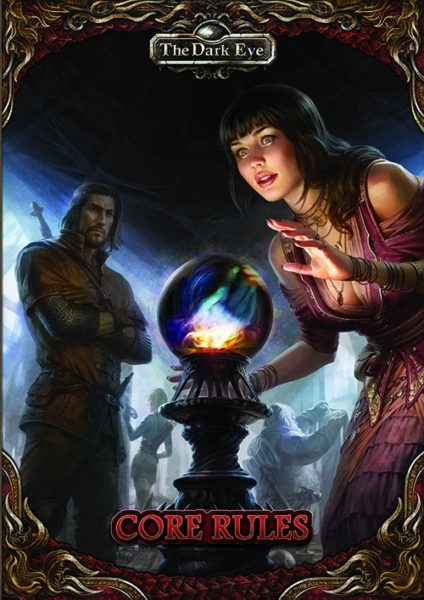 Many refer to The Dark Eye as Germany’s Dungeons and Dragons. It is a fantasy RPG featuring elves, mages, dwarves, and all the typical things one might expect from a fantasy RPG, and until recently, it was only offered in German. In November of 2016, however, the 5th edition of the game was translated into English, allowing thousands to finally dig in to the system that has captivated the gamers of Germany.
Many refer to The Dark Eye as Germany’s Dungeons and Dragons. It is a fantasy RPG featuring elves, mages, dwarves, and all the typical things one might expect from a fantasy RPG, and until recently, it was only offered in German. In November of 2016, however, the 5th edition of the game was translated into English, allowing thousands to finally dig in to the system that has captivated the gamers of Germany.
The book itself has over 400 pages, most of which is taken up by rules and character options. Setting details are tied into the mechanics, so readers will pick up various aspects about the world as they read. Unfortunately, the book only offers a brief overview of the setting otherwise. Readers hoping to get a full understanding of Dere — the world — or even Aventuria — the main continent — will have to do some independent research.
The setting has developed over 30 years, so there is a rich history to dig into. With 18 human cultures, 3 elven cultures, and 4 dwarven cultures, players and GMs alike have plenty of sources to draw inspiration from. On the other hand, a setting with so much history can be incredibly difficult to comprehend for newcomers. The fact that much of this development has taken place in German only compounds the challenge of fully understanding the world.
Learning the game is the equivalent of climbing a cliff up to a plateau. Up front, it is a lot of work. After finishing, however, it’s an even stroll forward. Character creation is likely to take hours, and it can be difficult to get used to the unorthodox central mechanic. Actual play seems very simple and smooth. By placing target numbers in plain view on a character sheet, players can instantly know whether they’ve succeeded or failed. There are some tricky rules, but most of those rules tie elegantly back into the core systems.
Mechanically, the game uses a unique system that asks players to roll under a character’s attributes on a d20. In combat, characters typically roll a single d20. For example, this means rolling under a character’s attack stat in order to land a hit. Skills, however, ask players to roll 3d20, rolling under 3 separate attributes to succeed. Players use skill points to adjust these rolls, spending them to reduce the value under a character’s attribute. Interestingly, this means that difficulties are more-or-less contained within a character. Instead of asking GMs to devise arbitrary difficulty thresholds, they just have to assign situational bonuses or penalties.
Character creation is one of the ways that the system shines. As a point-buy system, there are technically no classes to pigeonhole characters. Instead, there are voluminous options on which to spend character creation points. Skills, advantages, disadvantages, spells, races, professions, cultures, and more are all ways for a player to define their character, and each section has flavorful aspects that will likely serve to inspire unique concepts. The process can take a long time if a player wants to fully customize, but the game does offer point packages for players who want to streamline the process.
There is a ton of flavor in the different kinds of magic. The Dark Eye has the best representation of a witch that I have seen in a tabletop RPG, complete with curses, flying brooms, and creepy cat familiars. Guild mages study magic as scientists, and elves use their inherently magical nature to produce magical effects. Divine casters, called blessed ones, each have unique abilities based on the god that they worship. Spellcasters can further differentiate themselves through spell choice and further specialization into caster-specific special abilities. Compared to D&D, however, the spells are all low-level. There are certainly powerful spells, like invisibility and teleportation, but they have limitations that prevents mages from becoming plane-hopping, army-destroying super heroes.
Overall, The Dark Eye seems better suited for a “traditional” fantasy than Dungeons and Dragons. D&D quickly makes characters demigods, and for many (including myself), that is part of the appeal. Unfortunately, many who play D&D expects it to be closer to Lord of the Rings, which it just does not do well past lower levels. The Dark Eye, on the other hand, looks like it is perfect for a more reserved style of fantasy, even as players reach higher levels. It seems there is a reason that The Dark Eye is considered Germany’s D&D. I expect it offers something that many fantasy gamers have sought in D&D for a long time.
Available at DriveThruRPG: Quickstart Rules (free)
Available at DriveThruRPG: The Dark Eye – Core Rules
Available at Amazon: The Dark Eye – Core Rules


Nice review JB!
I reviewed The Dark Eye with KoDT. I thought the biggest challenge was getting past the terminology and keeping that in my mind. I might of said, D&D of Germany as well. The production value is top notch.